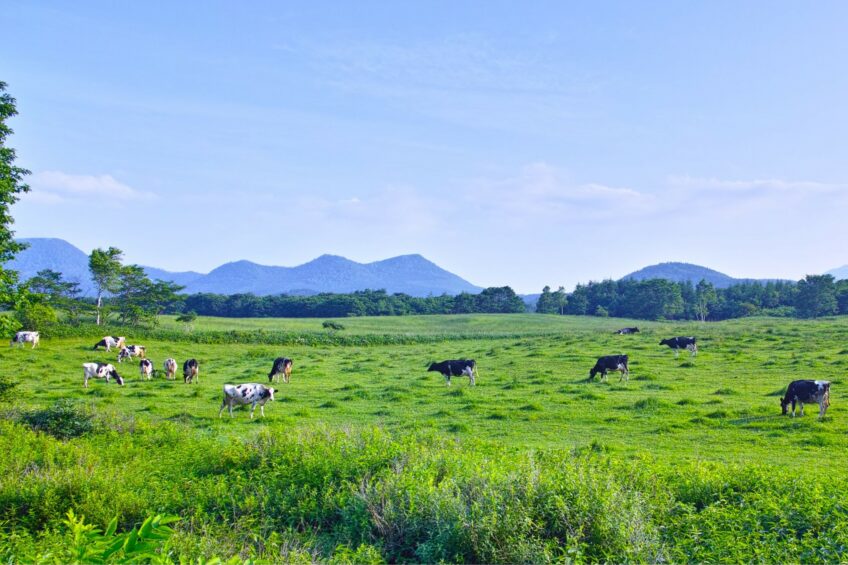Regenerative agriculture and dairy farming

Concerns regarding the relationship between dairy farming and climate change have led to discussions about the place of dairy farming in a sustainable food system. Regenerative agriculture, which focuses on naturalising greenhouse gas emissions from dairy farms and optimising soil carbon and nitrogen sequestration via dairy cow grazing, is considered a proper sustainable solution.
What are the principles of regenerative agriculture?
Regenerative agriculture is a naturalisation trajectory. It aims to pull excess greenhouse gases from the atmosphere and store them in the soil to improve soil health, water cycle, biodiversity, resilience to climate change, and maintain ecosystem services.
Regenerative agriculture consists of a group of principles implemented as a set of practices. The practices are common methods of farming and include rotational grazing, cover cropping, multi-cropping, and crop rotation, as well as using natural fertilisers such as manure.
Optimising soil carbon and nitrogen sequestration
Soil degradation and erosion are related to the unsustainability of the modern dairy production system. Excessive tillage, pesticide and artificial fertiliser application, simplified crop rotations, and separating dairy cows from arable farming due to intensive agricultural management result in soil erosion and degradation, reduced soil fertility and moisture retention.
Regenerative agriculture has developed a set of rotational grazing practices to increase environmental benefits and to optimise agricultural productivity. Rotational grazing involves choreographing the movement and grazing of dairy cows around small cells or parcels on the farm. This practice keeps the grass within the highest rates of photosynthesis in its growth cycle to maximise soil carbon sequestration. In addition, this practice gently disturbs the grass and tramples the manure into the ground to feed worms, insects, and microbes, to improve soil mineral content, enhance the productivity of successive crops, and to reduce dependence on costly synthetic fertilisers.
Adaptive multi-paddock grazing is a more effective form of rotational grazing in which one paddock is grazed at a time while other paddocks recover, and dairy cow numbers are adjusted as needed to match the forage available as conditions change. Under this method, soil microbial communities are diverse and healthy enough even to mitigate the methane produced by the dairy cow in real time. In addition, adaptive multi-paddock grazing restores ecosystem function and health and decreases the need for conventionally grown, annual feed crops that emit greenhouse gases.
Cover cropping, multi-cropping, and crop rotation
Monocropping, including planting a single crop, tillage, and leaving the land bare for long periods of time is a standard practice in modern-day agriculture. However, this practice increases the risk of soil erosion. Regenerative agriculture incorporates both diverse cover crops and crop rotations.
In this method, cover crops including wheat, barley, peas and clovers are planted during the times of rest or in combination with the primary crop to decrease soil erosion and agricultural runoff after rainstorms or irrigation. In addition, adding mixed species of cover crops and rotating crops enhances the carbon storage potential and improves soil health and microbiome diversity. Furthermore, crop rotation provides more nutrient-dense crops and reduces the need for petrochemical-based pesticides.
Manure is a natural fertiliser
Using dairy cow manure as a natural fertiliser lessens the need for energy-intensive petroleum-based chemical fertilisers and herbicides. In addition, applying fresh or composted dairy cow manure to cropland provides nutrients for plant growth, increases soil organic matter, improves soil physical conditions for growing crops, restores a healthy soil microbiome, increases the density of plants that cover the land surface, and also improves carbon and nitrogen store deep underground. Although cow manure is compost for crops and rangelands, it requires effective treatment for safe handling and effective plant uptake.
Challenges on the road to regeneration
Regenerative agriculture is gaining popularity across the dairy industry. However, there is still an ongoing debate about implementing regenerative agriculture in large conventional dairy production systems that do not focus primarily on grazing animals on pasture. In addition, large conventional dairy production systems typically store manure in a lagoon and apply it to farm fields as fertiliser. However, they may have more manure than they have land to spread it on, and it can be a challenge to keep the nutrients in the soil in balance and to protect the air and waterways from nitrogen and phosphorous runoff.
Another challenge is when a dairy farmer decides to plant cover crops or replace corn with a more environmentally friendly crop. They are then required to estimate whether the replacement crop will take up the same amount of nitrogen from the manure as the original crop would. Furthermore, dairy consumers will need to spend more to rapidly scale up applying regenerative agriculture in dairy farming. Without strong signals from consumers, not enough farmers will switch to regenerative practices in the timeframe needed to reverse current climate trends.
Conclusion
There are various valuable tools and practices in regenerative agriculture that can be applied in dairy farming to help us win the fight to reverse climate change. These practices are common methods of farming and include rotational grazing, cover cropping, multi-cropping, and crop rotation, as well as using natural fertilisers such as manure. However, further study is required to determine the extent to which the carbon can be sequestered in soil continuously and indefinitely.






